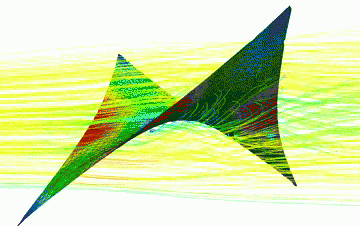Users:FSI
Contents |
Coupled Problems: Fluid-Structure Interaction
Carat++ can also be used within a coupled analysis of type fluid-structure interaction. What approach is used and how to setup a FSI-computation is explained here.
General Overview
A partitioned approach is used for simulating FSI problems. This means, that for each specific task of the coupled computation a specific program is used. The software envrionment in our case consists of three programms:
- the FE-code Carat++ for the solution of the structural subproblem,
- the FV-code OpenFOAM for the solution of the fluid subproblem,
- the coupling code CoMA, responsible for everything else: Simulation control, data transfer, communication, coupling algorithms, ...
A grafical representation fo this setup is given in the following figure:
To do a FSI-analysis all three programs have to be installed. Only a Linux-system can be used, because OpenFOAM is only available for Linux and cluster systems for HPC typically only run under Linux OS. The specific information on installation and problem setup of the three programs is given on the bottom of this page. After setup of the problem, the coupled computation is started by running all three programms at the same time, using MPI (Message Passing Interface):
mpiexec -n 1 pathToCarat/carat20.exe caratInputfile : -n 1 pathToCoMA CoMA.exe comaInputfiled : -n 2 OpenFOAM.exe -case pathToFoamCase -parallel
This command will start one carat process, one CoMA process and two OpenFOAM processes, so OpenFOAM runs in parallel.
Single Programs in Detail
The specific details on installation and problem setup of the three programs are described here:
General Overview_NEW
A partitioned approach is used for simulating FSI problems. This means, that for each specific task of the coupled computation a specific program is used. The software environment in our case consists of three programs:
- the FE-code Carat++ for the solution of the structural subproblem,
- the FV-code OpenFOAM for the solution of the fluid subproblem,
- the coupling tool EMPIRE, responsible for everything else: Simulation control, data transfer, communication, coupling algorithms, ...
To do a FSI-analysis all three programs have to be installed. Only a Linux-system can be used, because OpenFOAM is only available for Linux and cluster systems for HPC typically only run under Linux OS. The specific information on installation and problem setup of the three programs is given on the bottom of this page.
Carat++ FSI input file
The block provided below should be used for the application of coupled analysis using EMPIRE as a coupling tool.
NOTE: In order to run a coupled simulation of Carat++ with EMPIRE the compilation of Carat++ has to have the option CoSimulation ON in the CMakeLists.txt.
!############################################################################### !#### PC-BLOCK #### !############################################################################### !=============================================================================== PC-PROBLEM MASTERJOB = PC-ANALYSIS 1 !=============================================================================== !=============================================================================== PC-ANALYSIS 1: EMPIRE_CoSimulation CARAT_ANALYSIS = PC-ANALYSIS 2 COSIMULATION_INTERFACE = SURFACE 1 EMPIRE_INPUT_FILE = empireCarat.xml !===============================================================================
In addition, the co-simulation interface elements should be specified in the input file as shown below:
!############################################################################### !#### SURFACE-BLOCK #### !############################################################################### !=============================================================================== SURFACE 1 : ELEMENT 1, S1 2, S1 3, S1 4, S1 5, S1 6, S1 7, S1 8, S1 9, S1 10, S1 . . . !===============================================================================
The complete input file for the case of the Cavity benchmark can be downloaded here [1].
Single Programs in Detail
The specific details on installation and problem setup of the three programs are described here:
| Whos here now: Members 0 Guests 0 Bots & Crawlers 1 |



